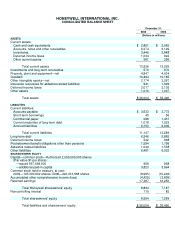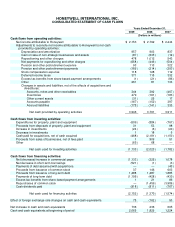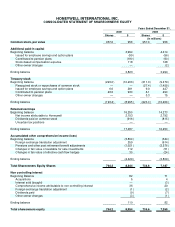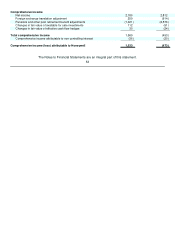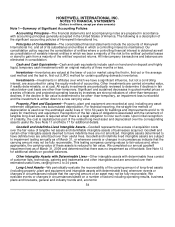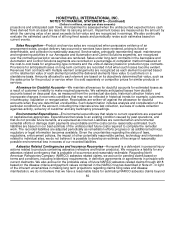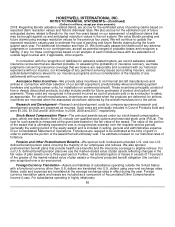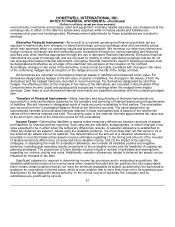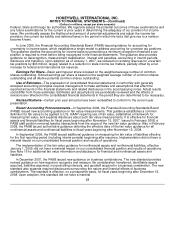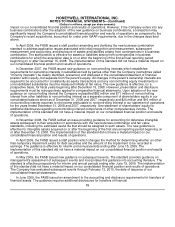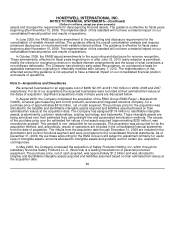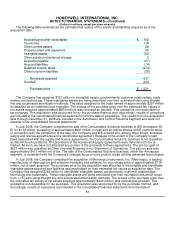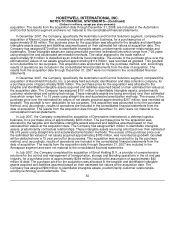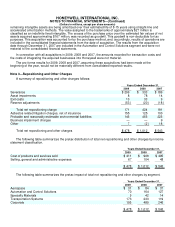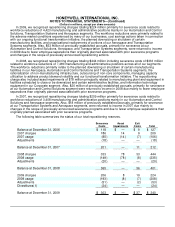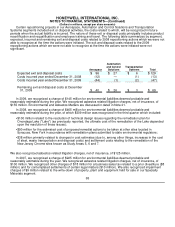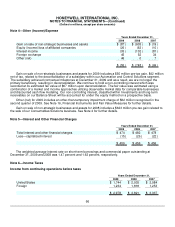Honeywell 2009 Annual Report Download - page 81
Download and view the complete annual report
Please find page 81 of the 2009 Honeywell annual report below. You can navigate through the pages in the report by either clicking on the pages listed below, or by using the keyword search tool below to find specific information within the annual report.
HONEYWELL INTERNATIONAL INC.
NOTES TO FINANCIAL STATEMENTS—(Continued)
(Dollars in millions, except per share amounts)
Federal, State and foreign tax authorities. We regularly assess the potential outcomes of these examinations and
any future examinations for the current or prior years in determining the adequacy of our provision for income
taxes. We continually assess the likelihood and amount of potential adjustments and adjust the income tax
provision, the current tax liability and deferred taxes in the period in which the facts that give rise to a revision
become known.
In June 2006, the Financial Accounting Standards Board (FASB) issued guidance for accounting for
uncertainty in income taxes, which establishes a single model to address accounting for uncertain tax positions.
The guidance clarifies the accounting for income taxes by prescribing a minimum recognition threshold a tax
position is required to meet before being recognized in the financial statements. The guidance also provides
guidance on derecognition, measurement classification, interest and penalties, accounting in interim periods,
disclosure and transition. Upon adoption as of January 1, 2007, we reduced our existing reserves for uncertain
tax positions by $33 million, largely related to a reduction in state income tax matters, partially offset by a net
increase for federal and international tax reserves.
Earnings Per Share—Basic earnings per share is based on the weighted average number of common
shares outstanding. Diluted earnings per share is based on the weighted average number of common shares
outstanding and all dilutive potential common shares outstanding.
Use of Estimates—The preparation of consolidated financial statements in conformity with generally
accepted accounting principles requires management to make estimates and assumptions that affect the
reported amounts in the financial statements and related disclosures in the accompanying notes. Actual results
could differ from those estimates. Estimates and assumptions are periodically reviewed and the effects of
revisions are reflected in the consolidated financial statements in the period they are determined to be necessary.
Reclassifications—Certain prior year amounts have been reclassified to conform to the current year
presentation.
Recent Accounting Pronouncements—In September 2006, the Financial Accounting Standards Board
(FASB) issued new accounting guidance on fair value measurements. This guidance establishes a common
definition for fair value to be applied to U.S. GAAP requiring use of fair value, establishes a framework for
measuring fair value, and expands disclosure about such fair value measurements. It is effective for financial
assets and financial liabilities for fiscal years beginning after November 15, 2007. Issued in February 2008, a
FASB staff position removed leasing transactions from the scope of the new fair value guidance. Also in February
2008, the FASB issued authoritative guidance deferring the effective date of the fair value guidance for all
nonfinancial assets and nonfinancial liabilities to fiscal years beginning after November 15, 2008.
In September 2009, the FASB issued additional guidance on measuring the fair value of liabilities effective
for the first reporting period (including interim periods) beginning after issuance. Implementation did not have a
material impact on our consolidated financial position and results of operations.
The implementation of the fair value guidance for nonfinancial assets and nonfinancial liabilities, effective
January 1, 2009, did not have a material impact on our consolidated financial position and results of operations.
See Note 16 for additional fair value information and disclosure for financial and nonfinancial assets and
liabilities.
In December 2007, the FASB issued new guidance on business combinations. The new standard provides
revised guidance on how acquirors recognize and measure the consideration transferred, identifiable assets
acquired, liabilities assumed, noncontrolling interests, and goodwill acquired in a business combination. The new
standard also expands required disclosures surrounding the nature and financial effects of business
combinations. The standard is effective, on a prospective basis, for fiscal years beginning after December 15,
2008. Upon adoption, this standard did not have a material
58


